Estimation of Residence Time and Transport Trajectory in Tieshangang Bay, China
Abstract
:1. Introduction
2. Materials and Methods
2.1. Study Area
2.2. Method
2.2.1. Hydrodynamic Module
2.2.2. Particle Tracking Module
3. Results
3.1. Residence Time for Tieshangang Bay
3.2. Transport Trajectories for Different Released Sources
4. Discussion
- (1)
- Some factors (e.g., degradation values, vertical dispersion, and settling velocity, etc.) that affect pollutant transport behavior were not incorporated in the current model, since it is the first time that a combined model has been employed to quantify the mean residence time of Tieshangang Bay based on long-time simulation (2004–2015). Hence, future study may be necessary to consider the abovementioned factors for more accurate estimation of the pollutant transport behavior.
- (2)
- The assumption of the 2D depth-averaged flow has the ability to represent the flow field of Tieshangang Bay in the current study. However, the water depth of the bay may reach up to 20 m in the main stream of the bay. Hence, it is reasonable to expect the pollutant transport behavior may change with different water depths. Therefore, the current study could be extended to a 3D model approach to investigate the water exchange of a similar bay.
5. Conclusions
Acknowledgments
Author Contributions
Conflicts of Interest
References
- Bilgili, A.; Proehl, J.A.; Lynch, D.R.; Smith, K.W.; Swift, M.R. Estuary/ocean exchange and tidal mixing in a gulf of Maine estuary: A lagrangian modeling study. Estuar. Coast. Shelf Sci. 2005, 65, 607–624. [Google Scholar] [CrossRef]
- Wang, L.N. Analysis of Hydrodynamic Characteristics Based on Random Walk Model in Tonkin Gulf. Master’s Thesis, Xiamen University, Xiamen, China, 2014. (In Chinese). [Google Scholar]
- Delhez, É.J.; Heemink, A.W.; Deleersnijder, É. Residence time in a semi-Enclosed domain from the solution of an adjoint problem. Estuar. Coast. Shelf Sci. 2004, 61, 691–702. [Google Scholar] [CrossRef]
- Fukumoto, T.; Kobayashi, N. Bottom stratification and water exchange in enclosed bay with narrow entrance. J. Coast. Res. 2005, 21, 135–145. [Google Scholar] [CrossRef]
- Yuan, D.; Lin, B.; Falconer, R.A. A modelling study of residence time in a macro-tidal estuary. Estuar. Coast. Shelf Sci. 2007, 71, 401–411. [Google Scholar] [CrossRef]
- Guo, W.; Wu, G.; Liang, B.; Xu, T.; Chen, X.; Yang, Z.; Jiang, M. The influence of surface wave on water exchange in the Bohai Sea. Cont. Shelf Res. 2016, 118, 128–142. [Google Scholar] [CrossRef]
- Nguyen, T.D.; Hawley, N.; Phanikumar, M.S. Ice cover, winter circulation, and exchange in Saginaw Bay and Lake Huron. Limnol. Oceanogr. 2017, 62, 376–393. [Google Scholar] [CrossRef]
- Zimmerman, J.T.F. Mixing and flushing of tidal embayments in the western Dutch Wadden Sea part I: Distribution of salinity and calculation of mixing time scales. Neth. J. Sea Res. 1976, 10, 149–191. [Google Scholar] [CrossRef]
- Dabrowski, T.; Hartnett, M.; Olbert, A.I. Determination of flushing characteristics of the Irish Sea: A spatial approach. Comput. Geosci. 2012, 45, 250–260. [Google Scholar] [CrossRef]
- Nguyen, T.D.; Thupaki, P.; Anderson, E.J.; Phanikumar, M.S. Summer circulation and exchange in the Saginaw Bay-Lake Huron system. J. Geophys. Res. Oceans 2014, 119, 2713–2734. [Google Scholar] [CrossRef]
- Li, Y.; Zhang, Q.; Yao, J. Investigation of residence and travel times in a large floodplain lake with complex lake-river interactions: Poyang Lake (China). Water 2015, 7, 1991–2012. [Google Scholar] [CrossRef]
- Chen, X. A laterally averaged two-dimensional trajectory model for estimating transport time scales in the Alafia River estuary, Florida. Estuar. Coast. Shelf Sci. 2007, 75, 358–370. [Google Scholar] [CrossRef]
- Guangxi Statistical Bureau. Guangxi Statistical Yearbook; China Statistics Press: Beijing, China, 2009. (In Chinese)
- Wang, L.N.; Pan, W.R.; Luo, Z.B.; Zhang, G.R. Numerical Simulation on Water Exchange in Tieshan Bay Based on a Random Walk Model. J. Xiamen Univ. 2014, 53, 840–847. (In Chinese) [Google Scholar]
- Jiang, C.B.; Li, Y.; Guan, Z.X.; Deng, B. Numerical simulation of water exchange capability before and after port construction in Tieshan Bay. J. Trop. Oceanogr. 2013, 32, 81–86. (In Chinese) [Google Scholar]
- Wei, M.X.; Lai, T.H.; He, B.M. Development Trend of the Water Quality Conditions in the Tieshangang Bay. Mar. Sci. Bull. 2002, 21, 69–74. (In Chinese) [Google Scholar]
- Li, S.; Meng, X.; Ge, Z.; Zhang, L. Evaluation of the threat from sea-level rise to the mangrove ecosystems in Tieshangang Bay, southern China. Ocean Coast. Manag. 2015, 109, 1–8. [Google Scholar] [CrossRef]
- Deng, C.L.; Li, G.Z.; Liu, J.H.; Liang, W. Submarine Dynamic Geomorphological Characteristics and Their Formation Cause in the Tieshan Harbor Area. Adv. Mar. Sci. 2004, 22, 170–176. (In Chinese) [Google Scholar]
- Meng, X.W.; Zhang, C.Z. Offshore Resources and Current Situation in Guangxi Coast; Ocean Press: Beijing, China, 2013. (In Chinese) [Google Scholar]
- Danish Hydraulic Institute (DHI). MIKE 21 Flow Model FM: Transport Module User Guide; DHI Water and Environment: Hørsholm, Denmark, 2014. [Google Scholar]
- Li, Y.; Yao, J. Estimation of Transport Trajectory and Residence Time in Large River–Lake Systems: Application to Poyang Lake (China) Using a Combined Model Approach. Water 2015, 7, 5203–5223. [Google Scholar] [CrossRef]
- Chubarenko, I.; Tchepikova, I. Modelling of man-made contribution to salinity increase into the Vistula Lagoon (Baltic Sea). Ecol. Model. 2001, 138, 87–100. [Google Scholar] [CrossRef]
- Babu, M.T.; Vethamony, P.; Desa, E. Modelling tide-driven currents and residual eddies in the Gulf of Kachchh and their seasonal variability: A marine environmental planning perspective. Ecol. Model. 2005, 184, 299–312. [Google Scholar] [CrossRef]
- Martinelli, L.; Zanuttigh, B.; Corbau, C. Assessment of coastal flooding hazard along the Emilia Romagna littoral, IT. Coast. Eng. 2010, 57, 1042–1058. [Google Scholar] [CrossRef]
- Mahanty, M.M.; Mohanty, P.K.; Pattnaik, A.K.; Panda, U.S.; Pradhan, S.; Samal, R.N. Hydrodynamics, temperature/salinity variability and residence time in the Chilika lagoon during dry and wet period: Measurement and modeling. Cont. Shelf Res. 2016, 125, 28–43. [Google Scholar] [CrossRef]
- Danish Hydraulic Institute (DHI). MIKE 21 Flow Model: Hydrodynamic Module User Guide; DHI Water and Environment: Hørsholm, Denmark, 2014. [Google Scholar]
- Danish Hydraulic Institute (DHI). MIKE 21: Toolbox User Guide; DHI Water and Environment: Hørsholm, Denmark, 2014. [Google Scholar]
- Liu, W.C.; Chen, W.B.; Hsu, M.H. Using a three-dimensional particle-tracking model to estimate the residence time and age of water in a tidal estuary. Comput. Geosci. 2011, 37, 1148–1161. [Google Scholar] [CrossRef]
- Piñones, A.; Hofmann, E.E.; Dinniman, M.S.; Klinck, J.M. Lagrangian simulation of transport pathways and residence times along the western Antarctic Peninsula. Deep Sea Res. Part II Top. Stud. Oceanogr. 2011, 58, 1524–1539. [Google Scholar] [CrossRef]
- Monsen, N.E.; Cloern, J.E.; Lucas, L.V.; Monismith, S.G. A comment on the use of flushing time, residence time, and age as transport time scales. Limnol. Oceanogr. 2002, 47, 1545–1553. [Google Scholar] [CrossRef]
- Takeoka, H. Fundamental concepts of exchange and transport time scales in a coastal sea. Cont. Shelf Res. 1984, 3, 311–326. [Google Scholar] [CrossRef]
- Ricciardulli, L.; Wentz, F.J.; Smith, D.K. 2011: Remote Sensing Systems QuikSCAT Ku-2011 Ocean Vector Winds on 0.25 Deg Grid, Version 4. Remote Sensing Systems: Santa Rosa, CA, USA. Available online: www.remss.com/missions/qscat (accessed on 2 May 2017).
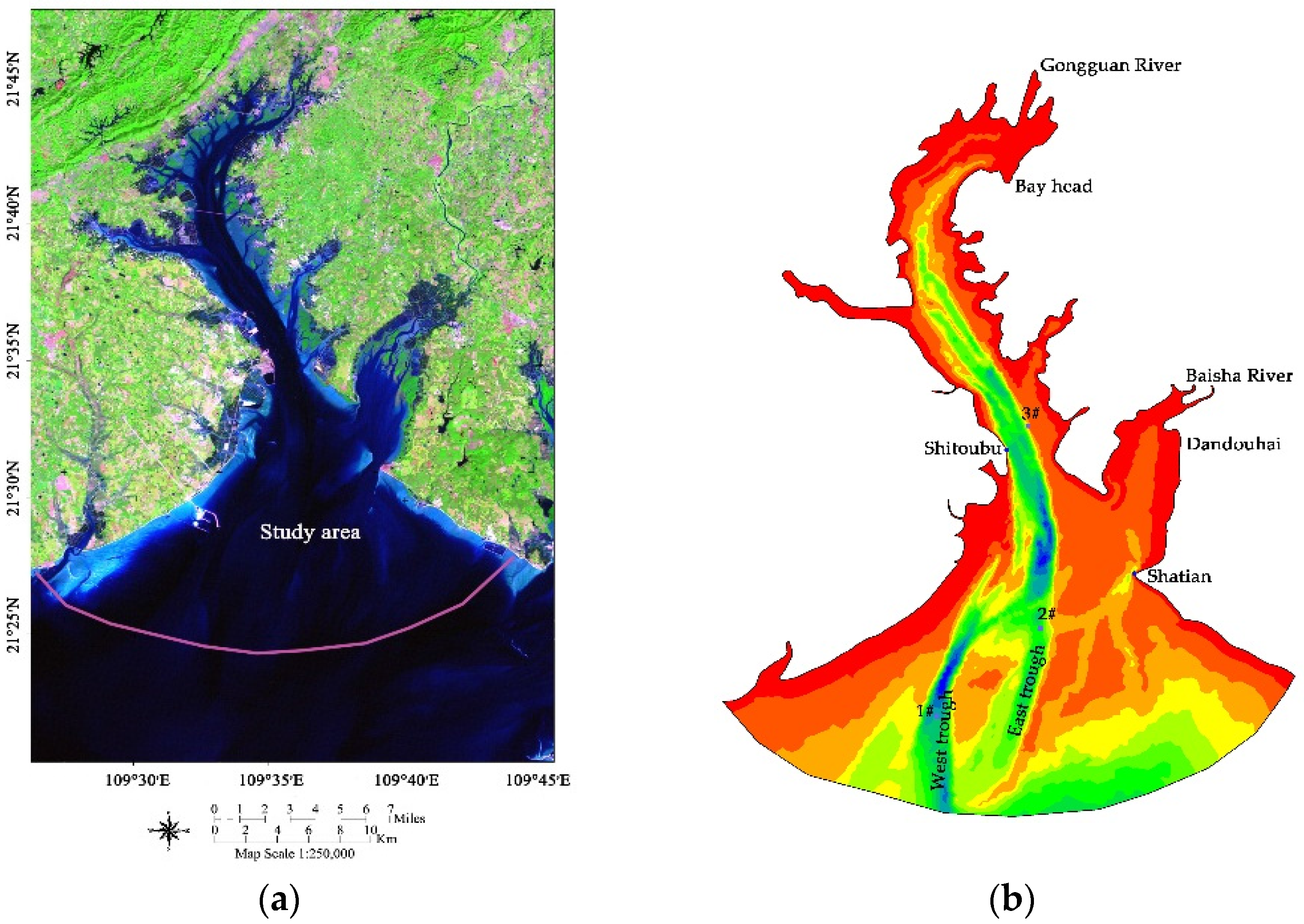
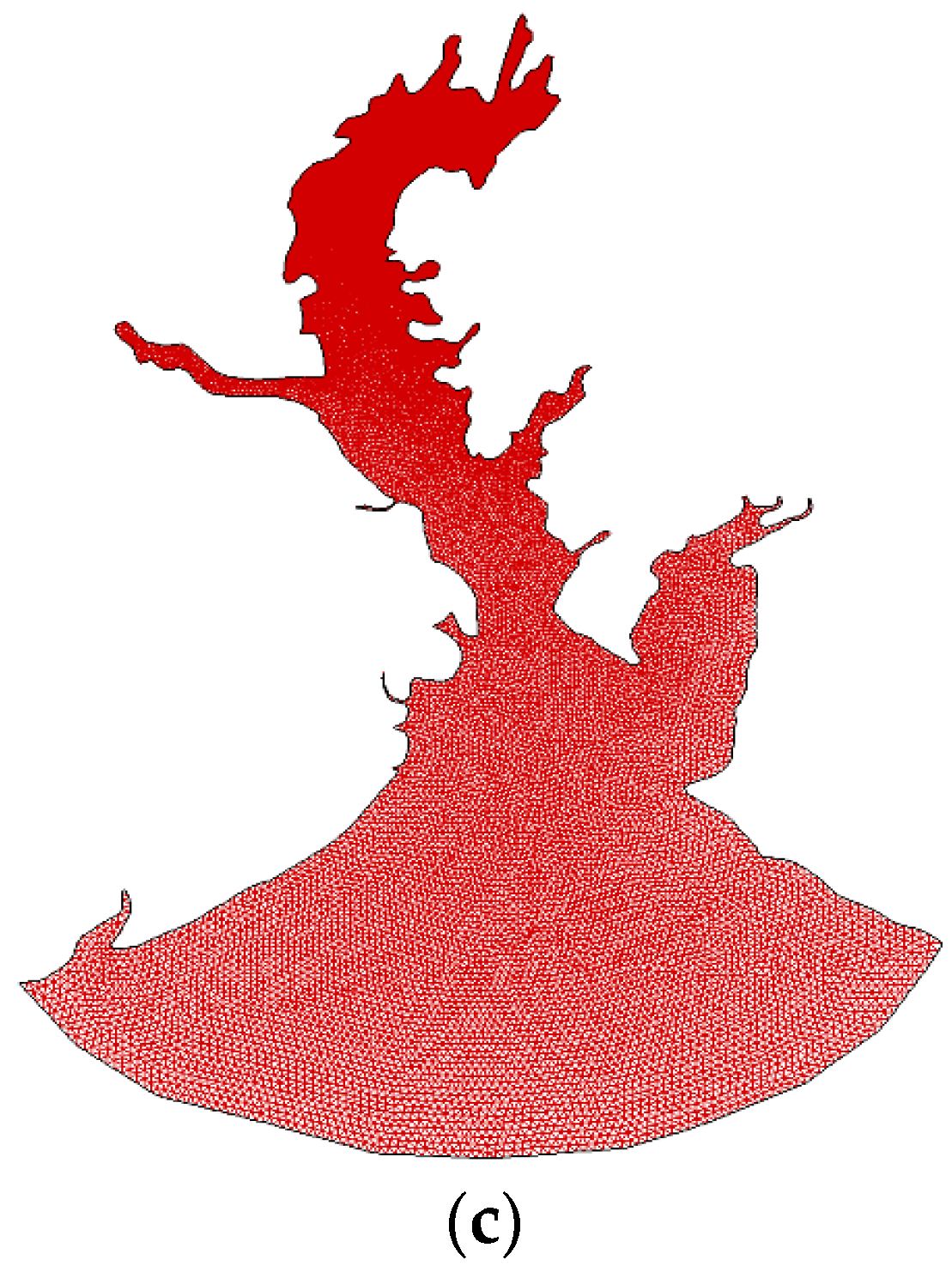
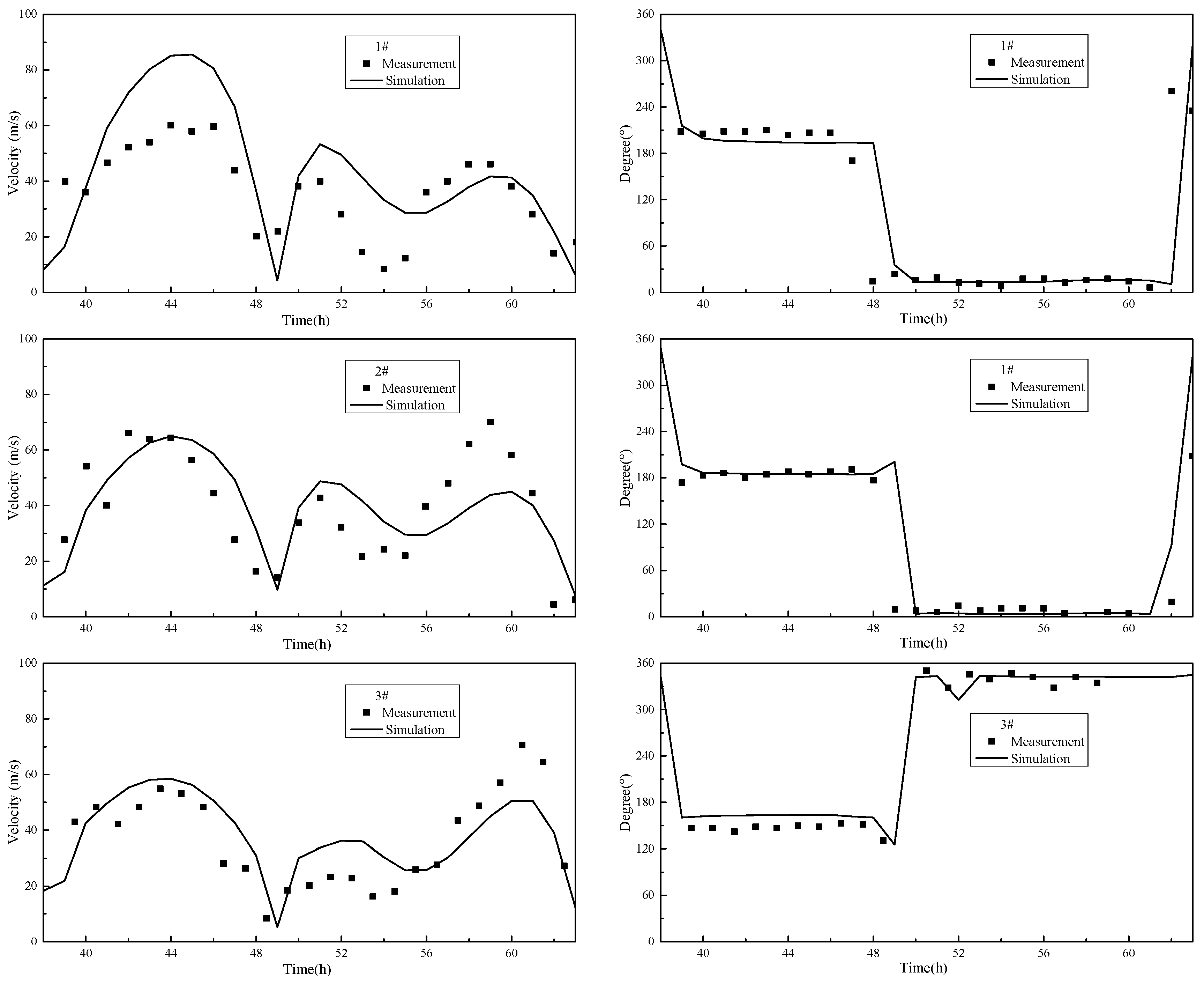
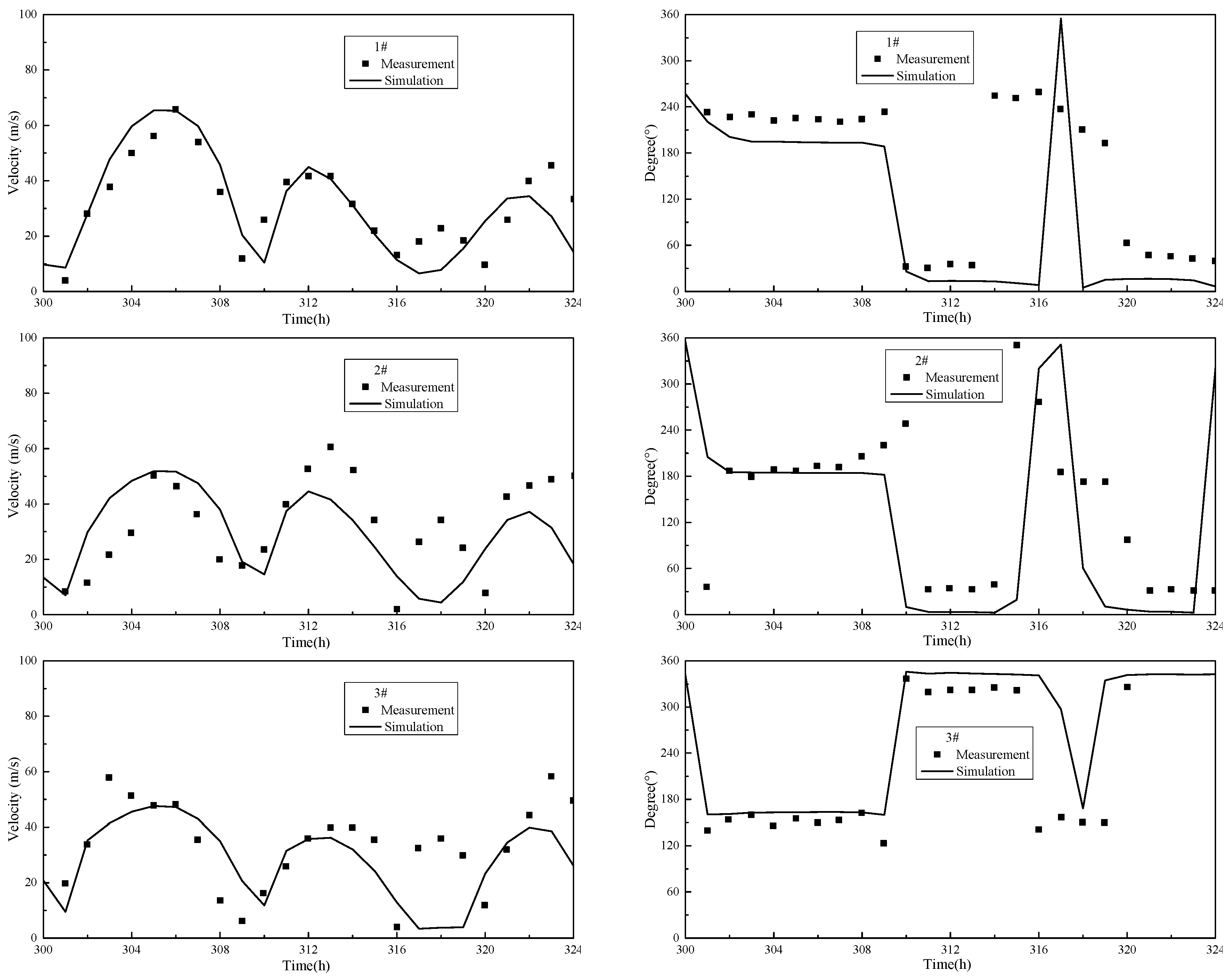
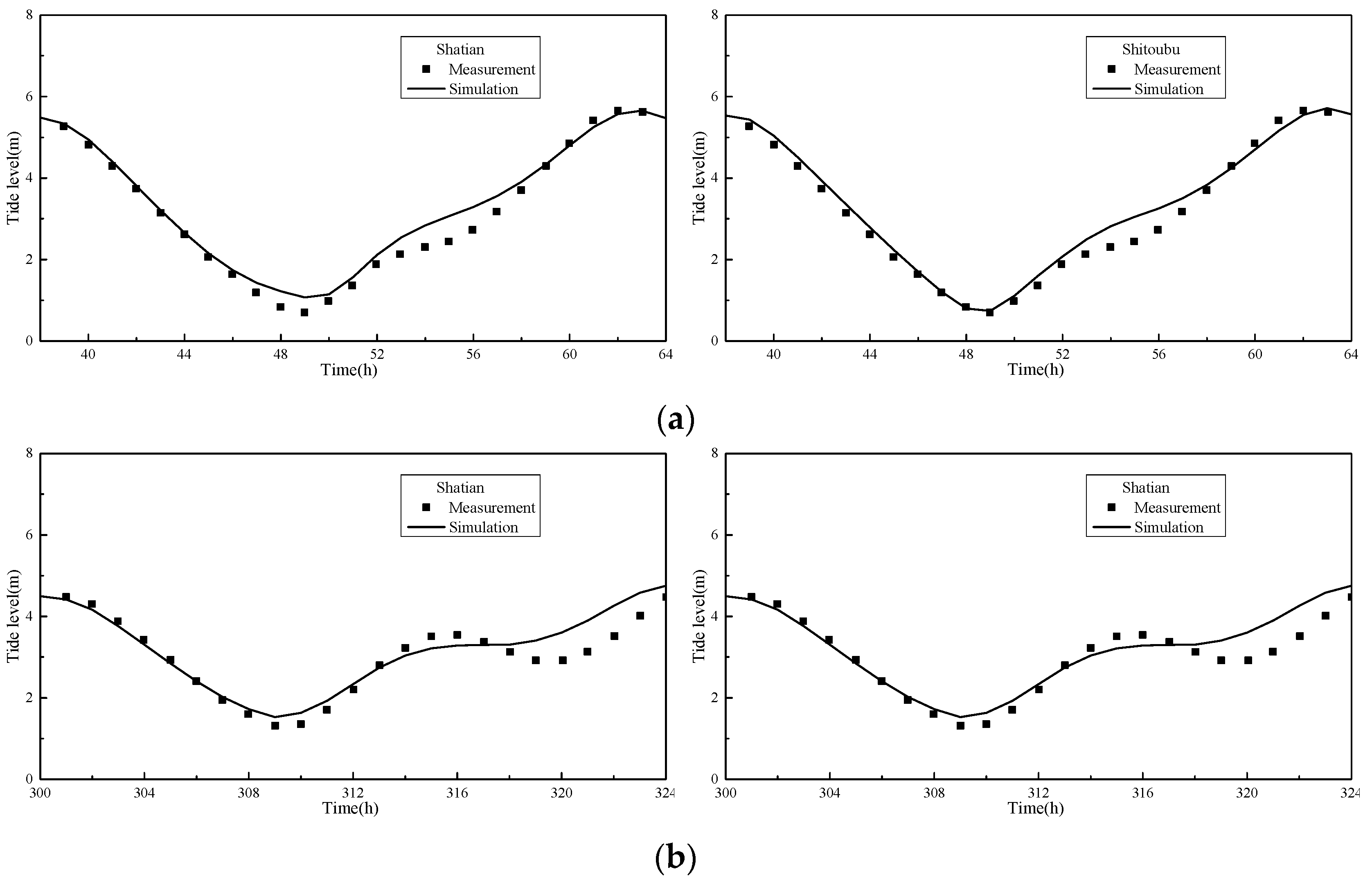
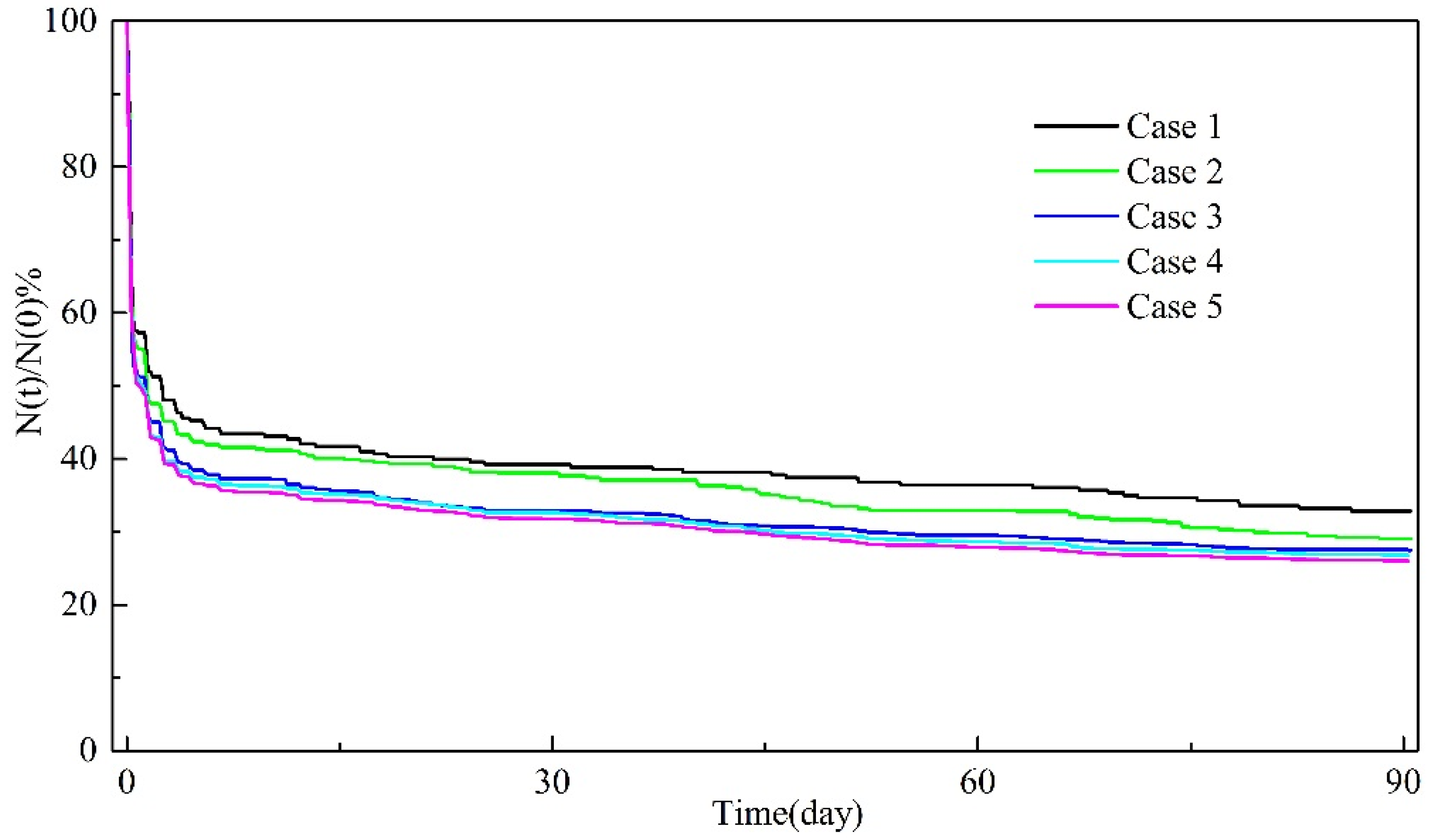
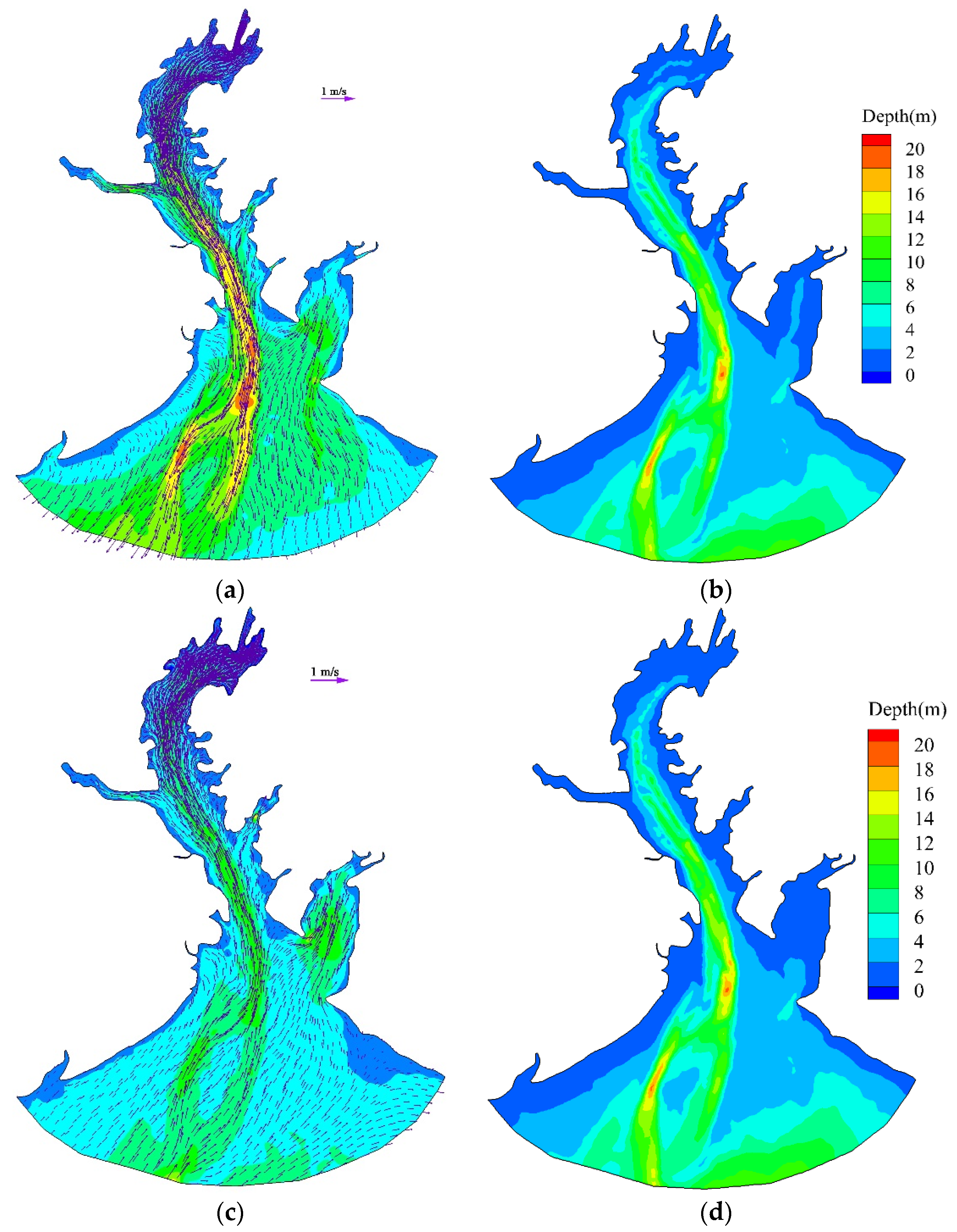
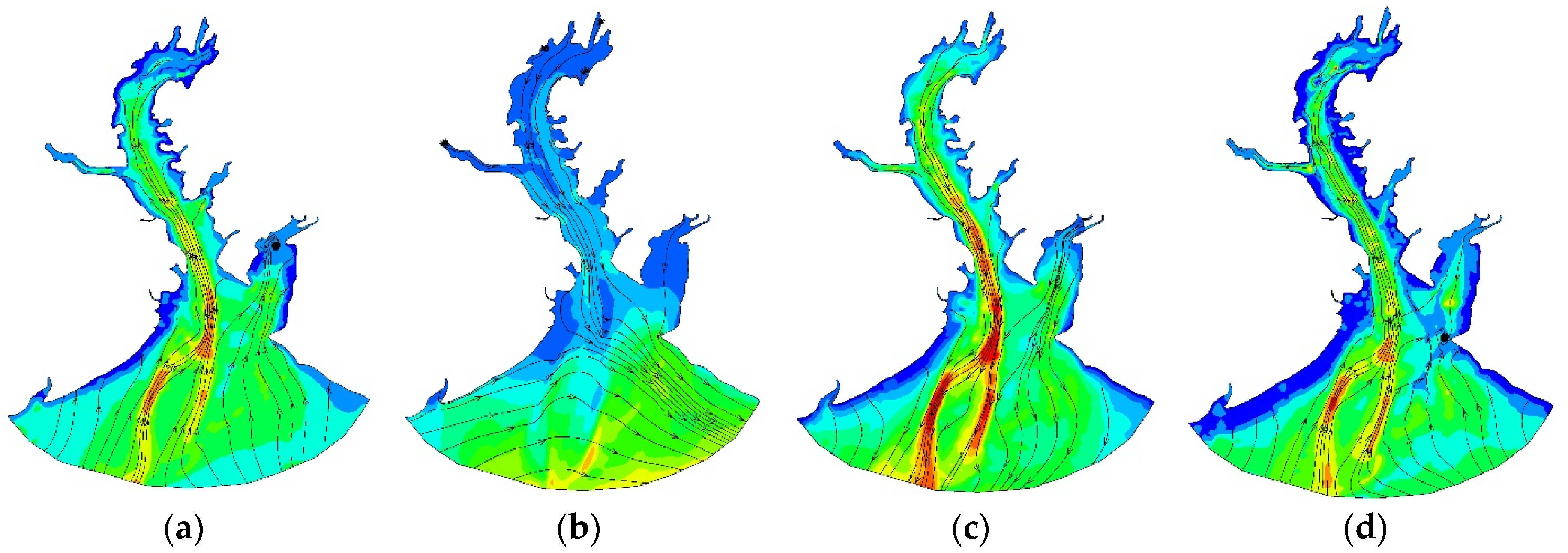
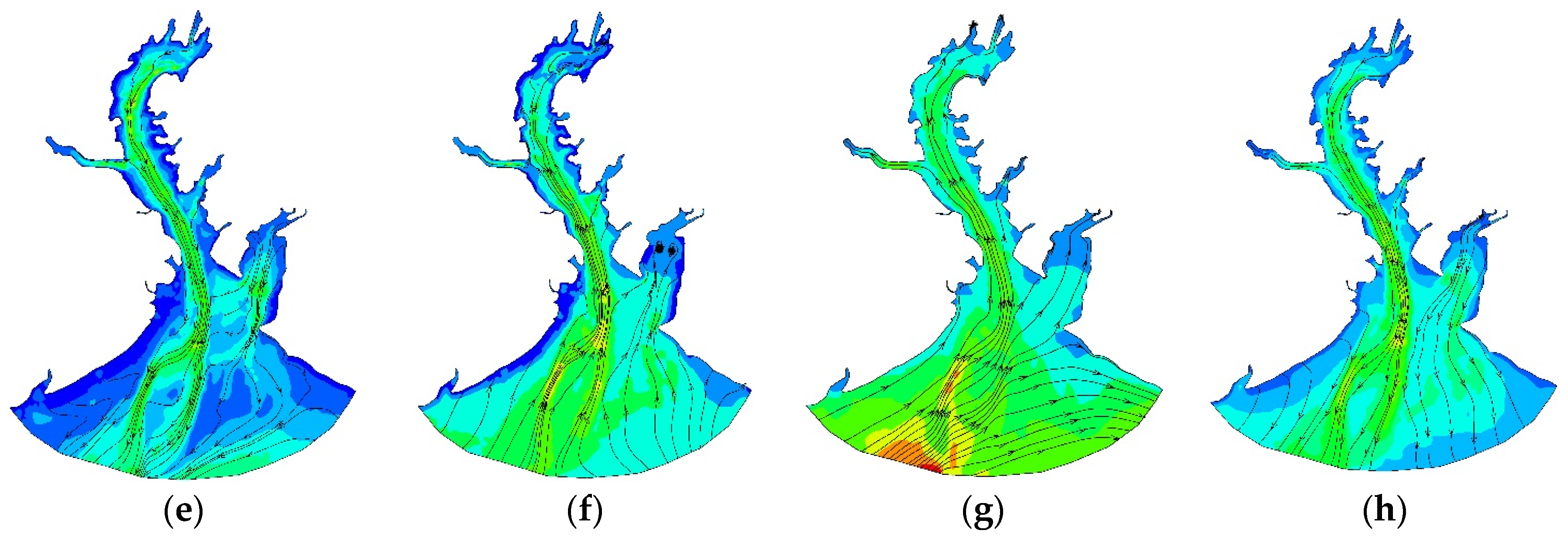
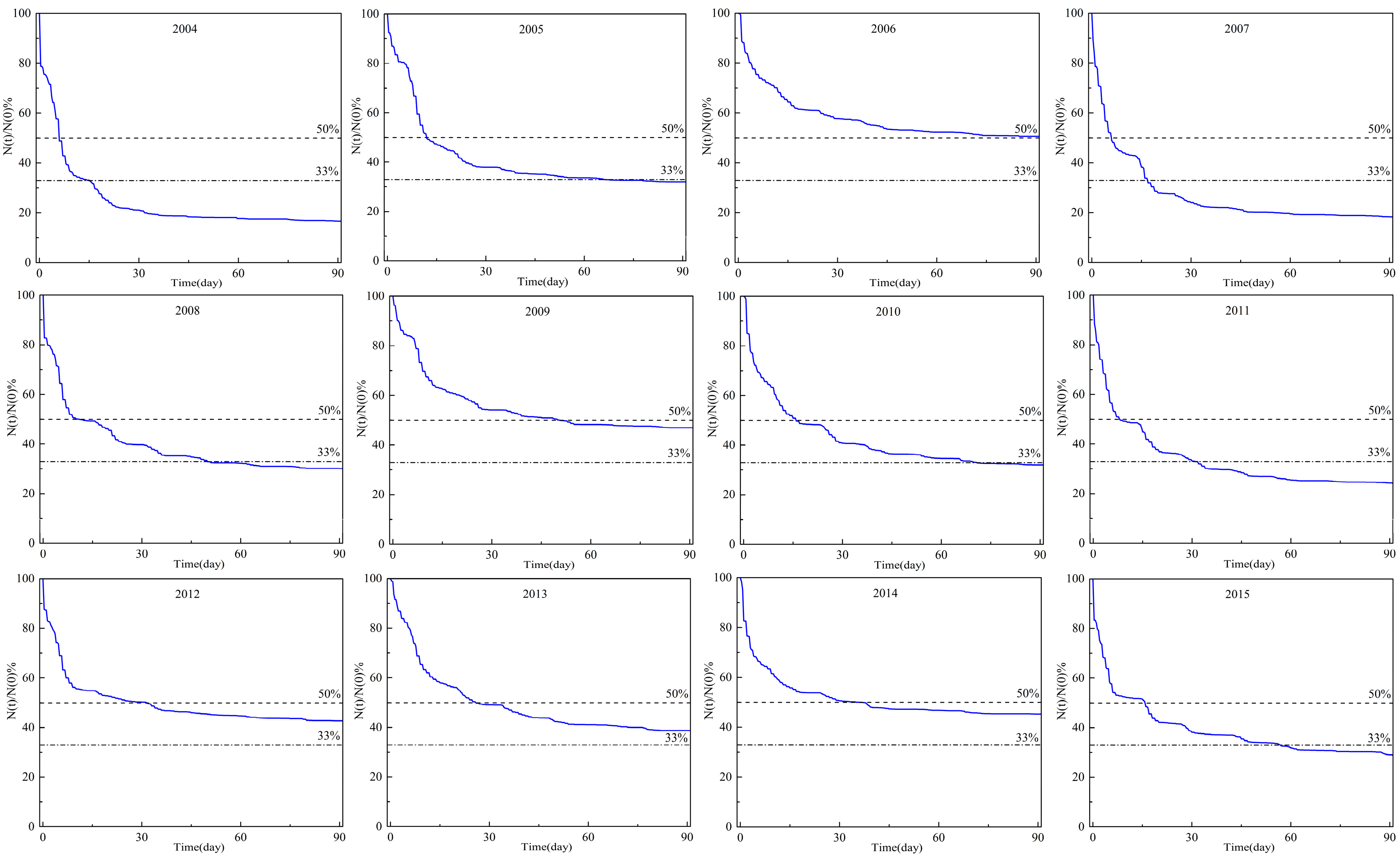

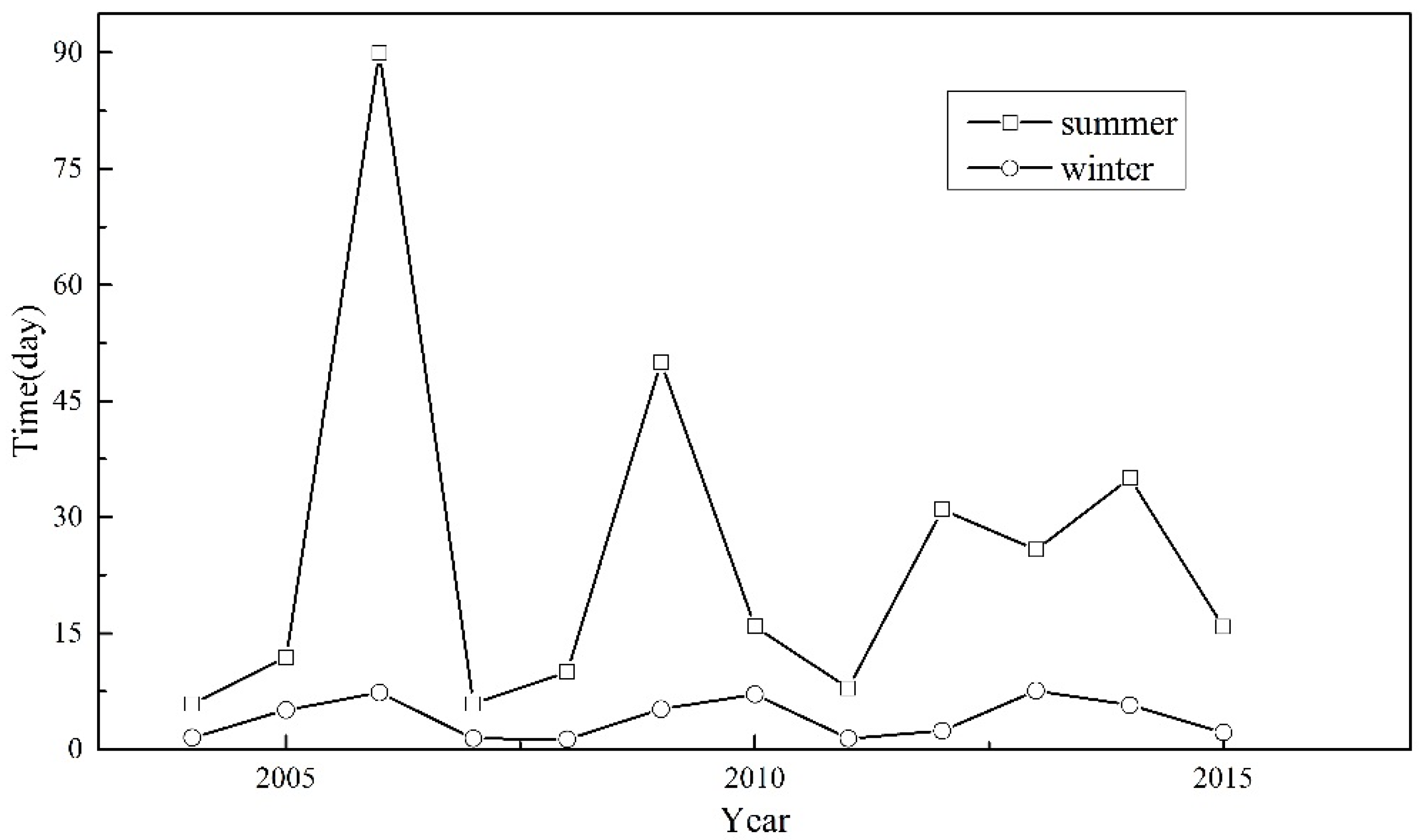

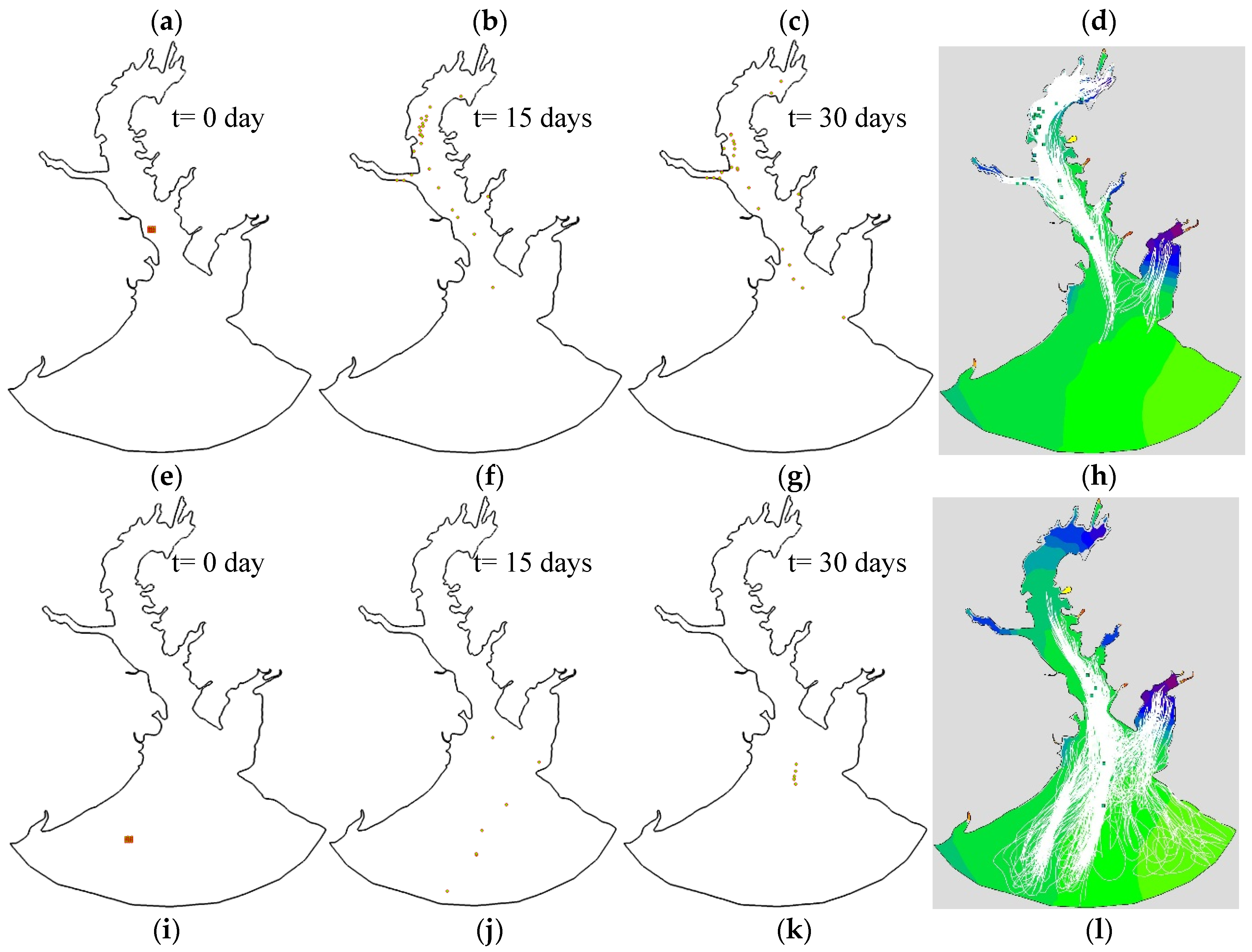
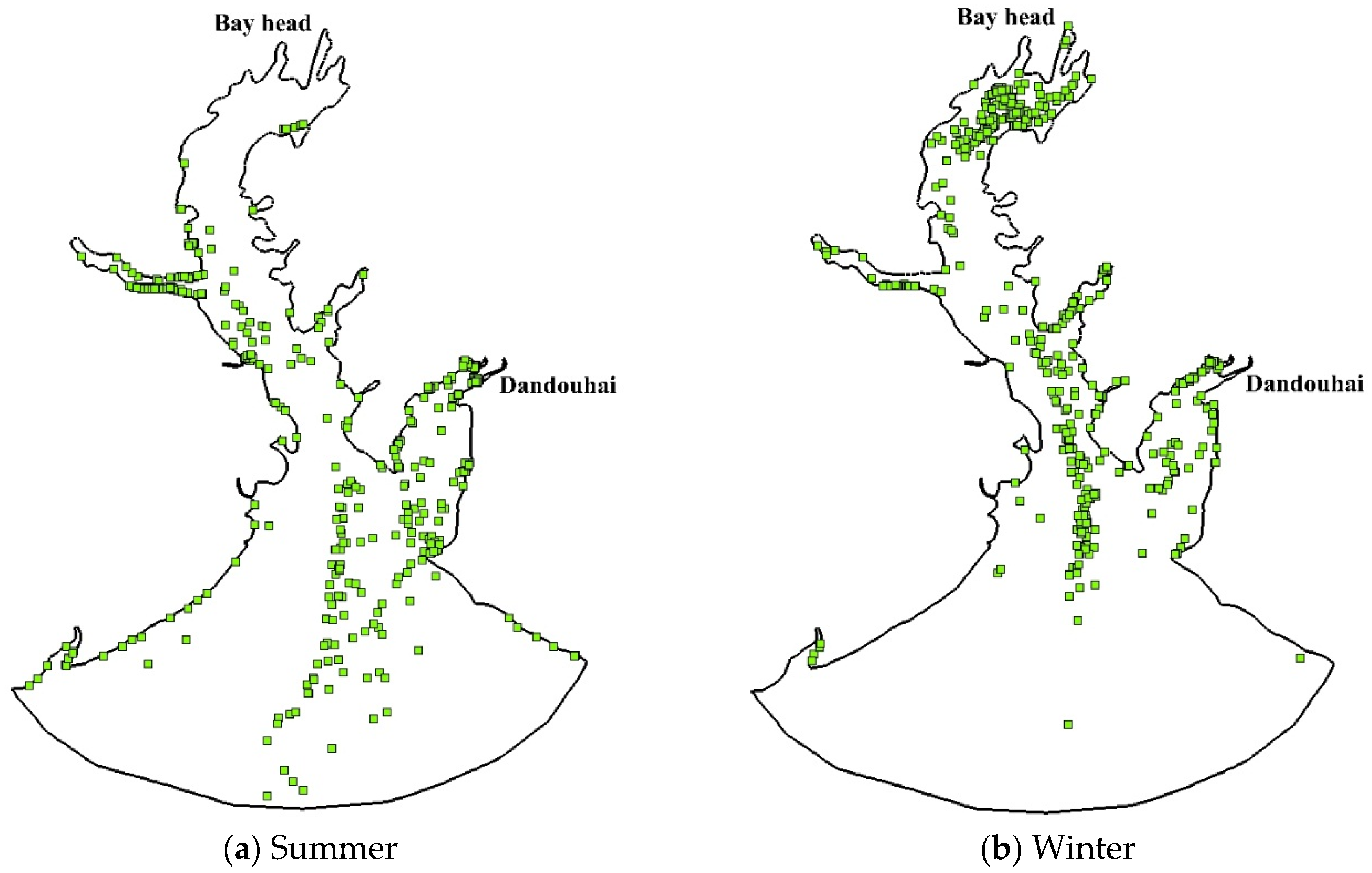
| Case | Numbers | Resolution | 30 Days | 60 Days | 90 Days |
|---|---|---|---|---|---|
| Percentage of Particles | |||||
| 1 | 283 | 2000 m × 1000 m | 39.2% | 36.4% | 32.9% |
| 2 | 534 | 2000 m × 500 m | 38.0% | 33.0% | 29.0% |
| 3 | 934 | 1000 m × 500 m | 32.9% | 29.6% | 27.5% |
| 4 | 1830 | 500 m × 500 m | 32.6% | 28.6% | 26.7% |
| 5 | 4430 | 500 m × 200 m | 31.8% | 27.9% | 26.0% |
| Parameter | Description | Values and Reference |
|---|---|---|
| M | Manning number | 32 m1/3/s [14,15] |
| Ev | Smagorinsky factor for eddy viscosity | 0.28 [20,21,26] |
| Sv | Settling velocity for particles | No settling [26] |
| DV | Vertical dispersion | No dispersion [26] |
| DH | Horizontal dispersion | Scaled eddy viscosity formulation [26] |
| Year | 2004 | 2005 | 2006 | 2007 | 2008 | 2009 | 2010 | 2011 | 2012 | 2013 | 2014 | 2015 |
|---|---|---|---|---|---|---|---|---|---|---|---|---|
| Summer | 14.8 | 65.8 | >92 | 16.8 | 49.8 | >92 | 70 | 30.6 | >92 | >92 | >92 | 56.8 |
| Winter | 8.6 | 90 | 57.6 | 24 | 16.3 | 26.8 | 90 | 34.3 | 20 | >92 | 89.8 | 8.8 |
© 2017 by the authors. Licensee MDPI, Basel, Switzerland. This article is an open access article distributed under the terms and conditions of the Creative Commons Attribution (CC BY) license (http://creativecommons.org/licenses/by/4.0/).
Share and Cite
Jiang, C.; Liu, Y.; Long, Y.; Wu, C. Estimation of Residence Time and Transport Trajectory in Tieshangang Bay, China. Water 2017, 9, 321. https://doi.org/10.3390/w9050321
Jiang C, Liu Y, Long Y, Wu C. Estimation of Residence Time and Transport Trajectory in Tieshangang Bay, China. Water. 2017; 9(5):321. https://doi.org/10.3390/w9050321
Chicago/Turabian StyleJiang, Changbo, Yizhuang Liu, Yuannan Long, and Changshan Wu. 2017. "Estimation of Residence Time and Transport Trajectory in Tieshangang Bay, China" Water 9, no. 5: 321. https://doi.org/10.3390/w9050321






